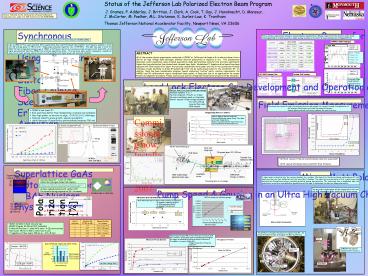Status of the Jefferson Lab Polarized Electron Beam Program - PowerPoint PPT Presentation
1 / 1
Title: Status of the Jefferson Lab Polarized Electron Beam Program
1
Status of the Jefferson Lab Polarized Electron
Beam Program J. Grames, P. Adderley, J.
Brittian, J. Clark, A. Cook, T. Gay, J.
Hansknecht, D. Mansour, J. McCarter, M.
Poelker, M.L. Stutzman, K. Surles-Law, K.
Trantham Thomas Jefferson National Accelerator
Facility, Newport News, VA 23606
Notice Authored by The Southeastern Universities
Research Association, Inc. under U.S. DOE
Contract No. DE-AC05-84150.
ABSTRACT All of the nuclear physics experiments
conducted at CEBAF at Jefferson Lab begin with an
electron beam from a 100 kV DC high voltage GaAs
photogun, whether electron polarization is
required or not. This presentation describes
recent experience using strained superlattice
GaAs photocathode material that provides
significantly higher electron polarization than
conventional strained layer GaAs. Modelocked
Ti-Sapphire drive lasers have been replaced with
fiber-based drive lasers that provide
considerably more power and rely on the
accelerator-friendly technique of gain switching
to obtain RF-pulsed light that can be easily
phase locked to the accelerator RF. In addition,
there has been considerable progress toward
conducting "routine" parity violation
experiments the HAPPEx and G0 collaborations
report exceptional beam quality, in large part
due to an appreciation for proper Pockels cell
alignment procedure. Finally, load lock gun and
low-voltage Mott polarimeter projects will be
discussed.
Superlattice GaAs Photocathodes for CEBAF Nuclear
Physics Program
- Wafer installed in Gun2 one year ago
- CEBAF Program 10-100 uA (417 Coulombs)
- 5 Heat/Activations 1 leaky NF3 valve 4 QE
restorations) - Heat cycle 45 min to 510 C, hold 1 hour cool
- TiSapphire or Fiber lasers 780 nm (f 0.5-1.5
mm)
surface charge limit































